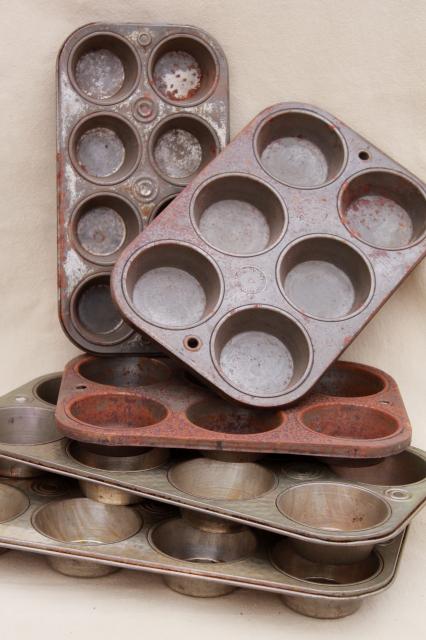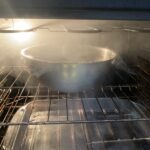Using updated bakeware not only makes the baking process easier, it also yields a finished product you can be confident in. Baked goods will stick in old pans where there is carbon build up, but they release easily from new or freshly restored pans. Some bakeware needs to be replaced every few years while other bakeware can be restored. See which category your bakeware falls into.
How often should I replace my cookie sheets?
Cookie sheets are a staple in any kitchen. From baking holiday cookies to roasting summer vegetables, you may find you use cookie sheets more frequently than any other bakeware in your home. Because of their versatility, cookie sheets go through a lot of wear and tear.
If you bake weekly, sheets need to be replaced every two years. If baking is more sporadic, they need replacing every five. However, how you care for your bakeware can prolong its life. Some bakers’ sheets will last a lifetime. So how do you know when your sheets need to be replaced? There are several telltale signs.
- If your cookie sheets are bent or cracked, they need to be replaced. Bent or cracked cookie sheets will cause your baked goods to bake unevenly. Even a dent in a cookie sheet can cause problems.
- If your nonstick cookie sheets are peeling or chipping, it’s time for new ones. Any damage to the nonstick surface can bake tiny bits of the material into your food.
- If your cookie sheets are stained and you do not wish to restore them, or you just feel the inspiration for new sheets – it’s time for a new set. Baking on a sheet that is dark from burnt food will impact the flavor and the bake. The flavor from the burnt food can transfer to what you are baking. And the dark colored pan will heat the food faster than a clean baking sheet.
The length of time needed for a new set depends on how often you use your baking sheets, the quality of the sheets, and whether you protect them with parchment, silicone mats, or aluminum foil each time you bake.
How often should I replace my cake pans?
Cake pans come in many shapes and sizes. They range from traditional round and sheet cake pans to molded pans like those used for bundt cake pans and more modern shaped cakes like castles. While cake pans are not as versatile as cookie sheets, they are also used for a number of recipes beyond just cake like cinnamon rolls, brownies, casseroles, and more.
Many of the same rules for replacing a cookie sheet apply to cake pans.
- If your cake pans are scratched they need to be replaced. This can easily happen when baked goods are sliced while in the cake pan. Any scratches can cause tiny pieces of the pan to break off and go into the food.
- If the shape is warped, it’s time to replace your cake pan. This could be dents or unevenness in the bottom of the pan or the sides. When your pan no longer retains its original shape, especially on the bottom of the pan, it can affect how evenly the pan bakes. If your pan is a cake mold, a dent or bend will distort the shape your cake bakes into.
- If your cake pans are stained and you do not plan to restore them, or you want new ones – treat yourself to a new set.

How often should I replace my muffin tins?
Muffin tins are often used less often than cookie sheets and cake pans, but their design makes them more difficult to clean. You may need to replace muffin pans as often as cookie sheets and cake pans. Here’s how to tell when it’s time for a new pan:
- If your muffin pan is warped, look for a replacement. Any unevenness in how the pan sits in your oven will cause it to bake inconsistently.
- If any of your muffin wells have scratches or scrapes, a replacement is needed. The cut material can cause bits of the metal to bake into your treats.
- If your nonstick muffin pan starts to rust or flake at all, it’s time for a new one. These flakes can end up in your muffins, cupcakes, etc.
- If your muffin pan is stained and you do not want to restore them, or you have your eye on a new one, it’s replacement time.
How often should I replace my baking tools?
You may be wondering, what other baking gear needs to be replaced? Here’s how to tell when your high use baking accessories need to be refreshed.
- Rubber spatulas – Replace every two years, or if they are melted, any pieces break off, or there is any mold between the rubber and handle
- Pastry and silicone brushes – Replace when they retain smells after washing and drying them or when their bristles start to fall out.
- Mixer blades on stand mixers – Replace when they are chipped.
- Wooden spoons or rolling pins – Replace when they are cracked, soft, or it takes them a long time to dry.
- Sifters – Replace if they have tears in the mesh. This can be dangerous to use as bits of metal can go into your baked goods.
- Microplanes or zesters – Replace if they are rusted or dull. With high use, these may need to be replaced annually.
Should you ever keep damaged bakeware?
Sometimes bakeware can have sentimental value, like your grandmother’s rolling pin that was passed down to you! These heirlooms are wonderful keepsakes. Once they are showing substantial wear and tear it’s best to display them in your kitchen and buy replacement bakeware for your regular use.
When can my bakeware be restored?
Take a look at your metal bakeware. Chances are they no longer look new, but this doesn’t mean they need to be replaced. Cookie sheets, cake pans, and muffin tins will become stained with time. This darkening comes from oils or burnt food. These are usually cosmetic. As long as there is no nonstick coating, your metal bakeware can be restored with this easy approach.
Layer baking soda, followed by hydrogen peroxide, followed by another layer of baking soda. Allow them to sit for 1-2 hours then wipe clean with a sponge or washcloth.
How do I extend the life of my bakeware?
- Buy quality bakeware. Baking sheets, cake pans, and muffin tins should be thick, though they do not need to be heavy. The thickness makes them sturdy and less likely to warp when properly cared for.
- Protect your bakeware with appropriately sized silicone baking mats, parchment paper, aluminum foil, or baking cups.
- Opt to hand wash and towel dry your bakeware instead of dishwashing. Dishwashers expose bakeware to conditions that age it faster. High temperatures and sitting water or steam can erode and rust your bakeware. Plus, a dishwasher won’t get into the nooks and crannies or put in the elbow grease needed to remove baked on or burnt food. You can clean your stainless steel bakeware (not non-stick) with steel wool and dish soap to prevent carbon build up and increase the longevity of your sheets.
- Wait for a pan to cool before washing it. Cold water on a hot pan can cause it to warp. It’s best to wait until the pan cools, then clean it with warm, soapy water.


